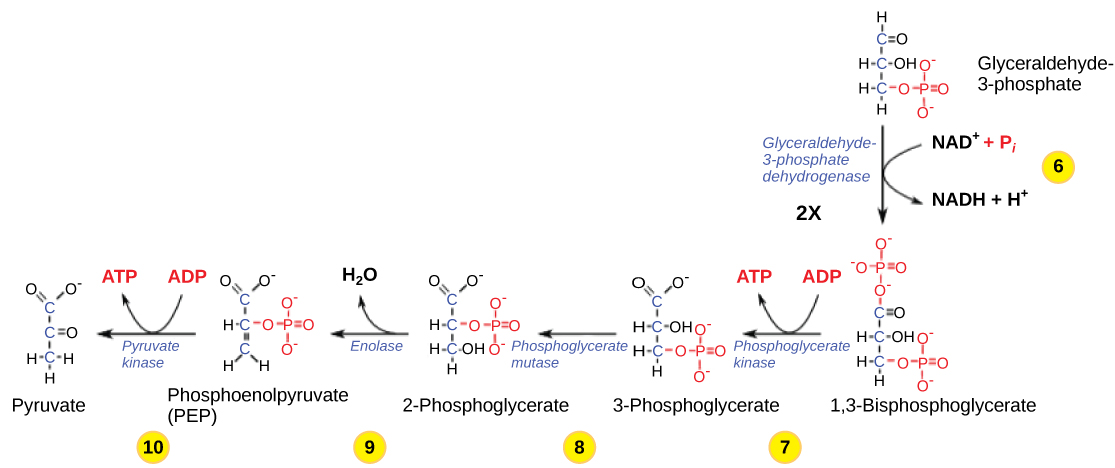| << Chapter < Page | Chapter >> Page > |
Step 6. The sixth step in glycolysis ( [link] ) oxidizes the sugar (glyceraldehyde-3-phosphate), extracting high-energy electrons, which are picked up by the electron carrier NAD + , producing NADH. The sugar is then phosphorylated by the addition of a second phosphate group, producing 1,3-bisphosphoglycerate. Note that the second phosphate group does not require another ATP molecule.

Which of the following characteristics apply to reaction 6 in figure 2 above?
e
The energy released by glucose oxidation is captured on______ and_____.
a
Here again is a potential limiting factor for this pathway. The continuation of the reaction depends upon the availability of the oxidized form of the electron carrier, NAD + . Thus, NADH must be continuously oxidized back into NAD + in order to keep this step going. If NAD + is not available, the second half of glycolysis slows down or stops. If oxygen is available in the system, the NADH will be oxidized readily, though indirectly, and the high-energy electrons from the hydrogen released in this process will be used to produce ATP. In an environment without oxygen, an alternate pathway (fermentation) can provide the oxidation of NADH to NAD + .
Step 7. In the seventh step, catalyzed by phosphoglycerate kinase (an enzyme named for the reverse reaction), 1,3-bisphosphoglycerate donates a high-energy phosphate to ADP, forming one molecule of ATP. (This is an example of substrate-level phosphorylation.) A carbonyl group on the 1,3-bisphosphoglycerate is oxidized to a carboxyl group, and 3-phosphoglycerate is formed.
Step 8. In the eighth step, the remaining phosphate group in 3-phosphoglycerate moves from the third carbon to the second carbon, producing 2-phosphoglycerate (an isomer of 3-phosphoglycerate). The enzyme catalyzing this step is a mutase (isomerase).
Step 9. Enolase catalyzes the ninth step. This enzyme causes 2-phosphoglycerate to lose water from its structure; this is a dehydration reaction, resulting in the formation of a double bond that increases the potential energy in the remaining phosphate bond and produces phosphoenolpyruvate (PEP).
Step 10. The last step in glycolysis is catalyzed by the enzyme pyruvate kinase (the enzyme in this case is named for the reverse reaction of pyruvate’s conversion into PEP) and results in the production of a second ATP molecule by substrate-level phosphorylation and the compound pyruvic acid (or its salt form, pyruvate). Many enzymes in enzymatic pathways are named for the reverse reactions, since the enzyme can catalyze both forward and reverse reactions (these may have been described initially by the reverse reaction that takes place in vitro, under non-physiological conditions).
Gain a better understanding of the breakdown of glucose by glycolysis by visiting this site to see the process in action.
Unfortunately, glycolysis by itself can leave the cell with a problem; how to regenerate NAD + from the 2 molecules of NADH produced. If the NAD + is not regenerated all of the cell's NAD will be transformed into NADH. This would then cause glycolysis to come to a halt. So how do cells regenerate NAD + , they oxidize the NADH completing the cycle by reducing another compound, usually a small metabolite, such as pyruvate. This process is called fermentation . The reduction of pyruvate or another small metabolite leads to the reoxidation of NADH to NAD + and the production of a fermentation product such as lactate, acetate, ethanol or some other product. We will discuss fermentation reactions shortly.
The last step in glycolysis is the production of pyruvate. Pyruvate, has a variety of cell fates. In cells that lack an electron transport chain, pyruvate or a breakdown product can act as a terminal electron acceptor in a fermentation reaction necessary to regenerate NAD + from the NADH produced during glycolysis. Alternatively, Pyruvate can be oxidized to acetyl~CoA which can then be used as the starting point for the Tricarboxcylic Acid Cycle (TCA Cycle) or Krebs Cycle . This will generate additional ATP (equivalents) NADH and additional precursors necessary for the building of monomers and bio-polymers.
The flow of carbon through glycolysis can be described as:
b
Glycolysis
Insert Solution Text Here
Glycolysis is the first pathway used in the breakdown of glucose to extract energy. It was probably one of the earliest metabolic pathways to evolve and is used by nearly all of the organisms on earth. Glycolysis consists of two parts: The first part prepares the six-carbon ring of glucose for cleavage into two three-carbon sugars. ATP is invested in the process during this half to energize the separation. The second half of glycolysis extracts ATP and high-energy electrons from hydrogen atoms and attaches them to NAD + . Two ATP molecules are invested in the first half and four ATP molecules are formed by substrate phosphorylation during the second half. This produces a net gain of two ATP and two NADH molecules for the cell.

Notification Switch
Would you like to follow the 'Ucd bis2a intro to biology v1.2' conversation and receive update notifications?